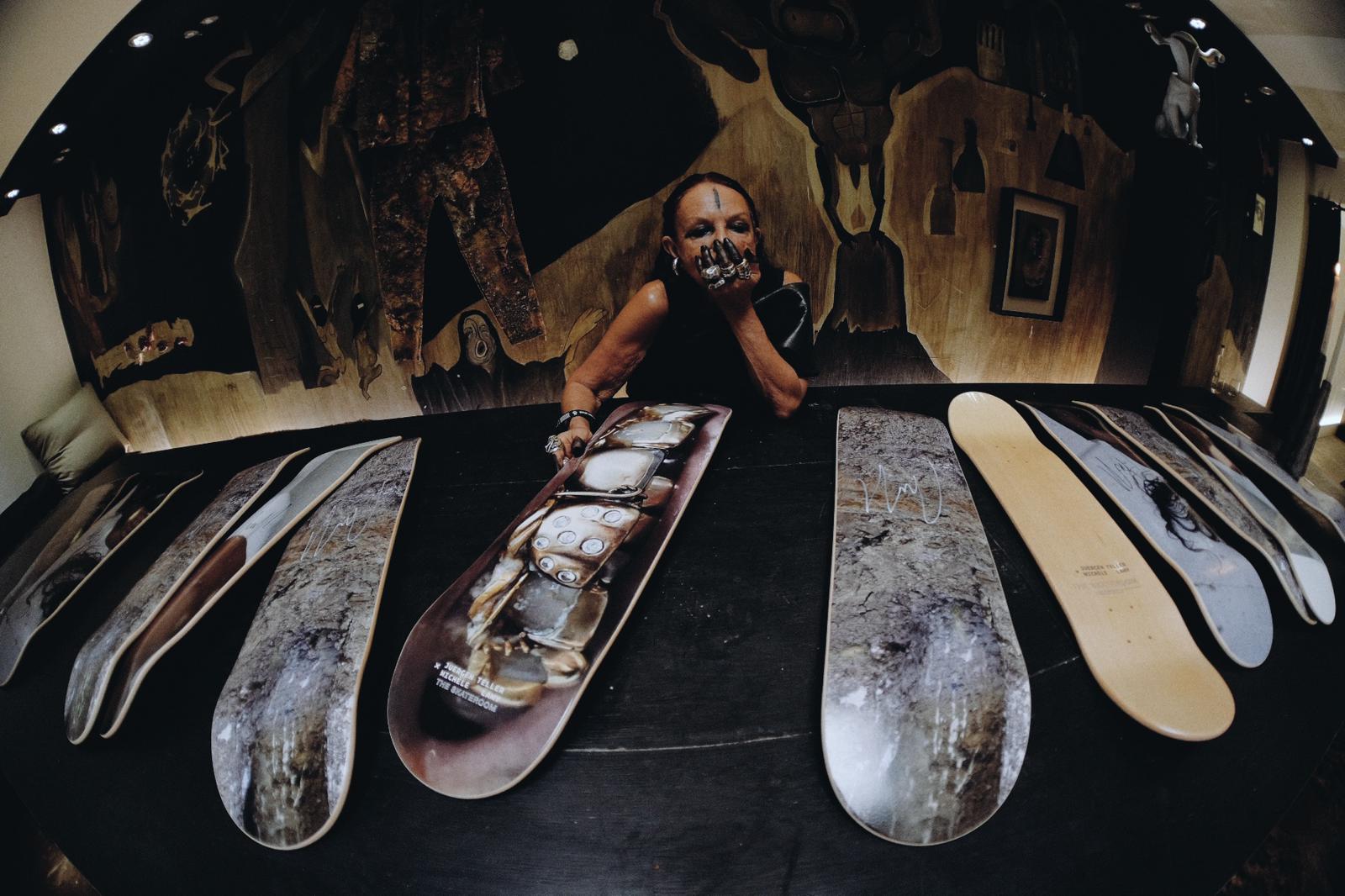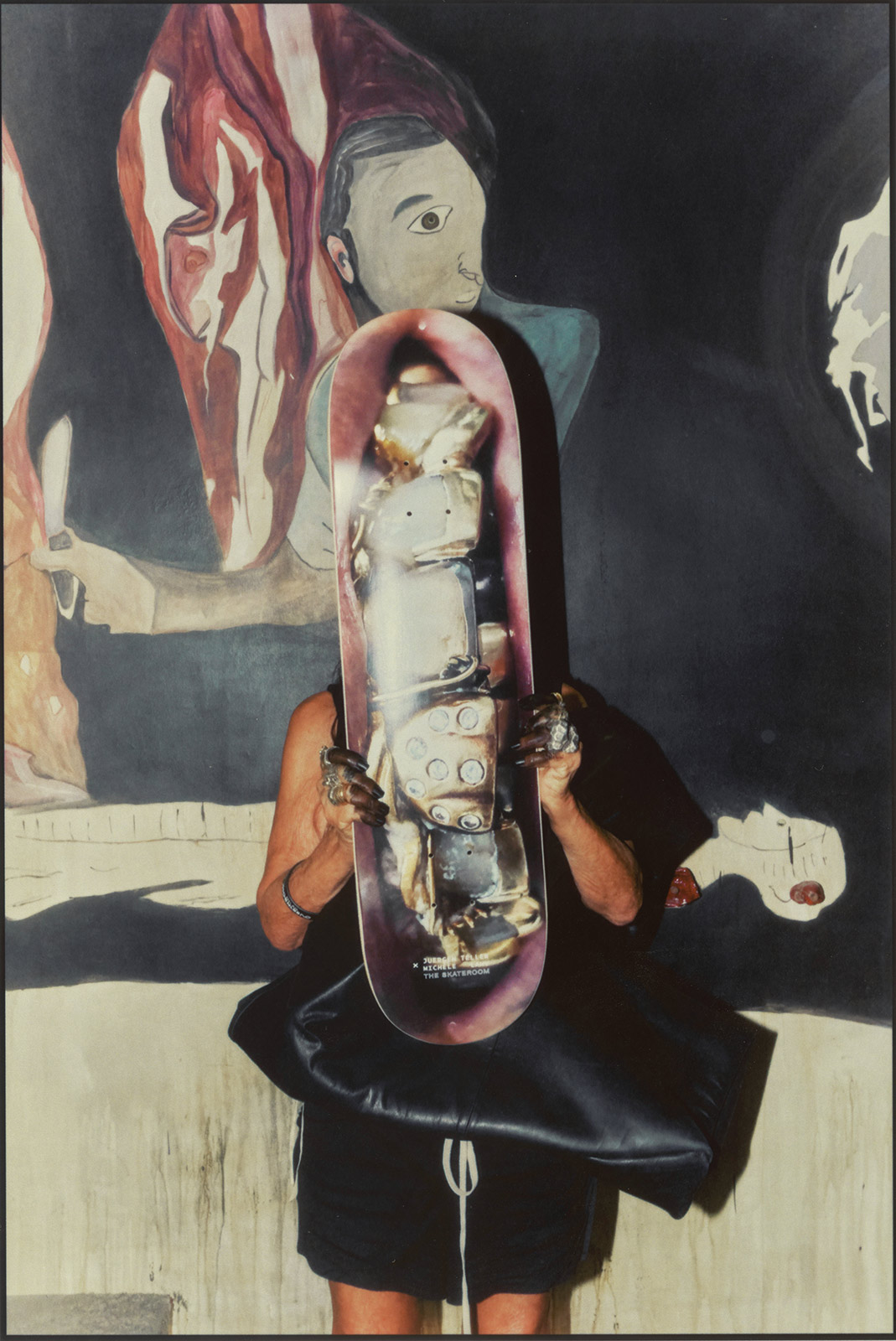The creative multihyphenate isn’t afraid to show teeth across an exclusive collection of art decks, shot by Jeurgen Teller
Solipsism is defined philosophically as the concept that only the self can be known as real. It’s only logical, especially given the increasingly individualistic society that we live in. Michèle Lamy—one of the few modern-day cultural figures deserving of the title multihyphenate—represents solipsism’s opposite, favoring the idea of a thriving, united, capital-W World in which all citizens are connected through art.
This people-first notion is tantamount to understanding Lamyland—a collective named after the highly-esteemed creative, but centering a slew of global artistic communities. Lamyland has long been interested in the culture surrounding skateboarding, producing Turning Tricks last year, an art show about the birth of the craft co-curated with pro skater Danny Minnick. The organization also launched What Are We Skating For? that spring, a group show by the Skateroom—a company founded by enthusiast and collector Charles-Antoine Bodson, focused on “leveraging the transformative power of art and skateboarding to facilitate and support social impact initiatives in at-risk communities around the world.”
For her second collaboration with the Skateroom, Lamy dropped an exclusive collection of decks featuring photos taken of her by Juergen Teller at ComplexCon. Building on Lamyland’s recently ramped-up (pun intended) skate enterprises, Document touches base with Charles-Antoine Bodson and the woman herself, discussing skateboarding’s history as a revolutionary act.
Maya Kotomori: Tell me about this collaboration with the Skateroom.
Michèle Lamy: We first built a skate park in Marrakech for a Lamyland project. This second project has even more incentive for me, because the revenue from these boards [goes toward] providing movable skate parks in refugee camps. I’m counting on the world to have a drop of good sense, to help us feel that human nature is not fucked up forever. I’m an exhausting optimist.
Maya: How were the images for both triptychs and the pentaptych selected and arranged?
Michèle: These images were shot by Juergen Teller for the inaugural issue of System Beauty. I’m so pleased that he agreed to participate, as the freak artist that he is, to push me in these pictures. I’m hoping they will help us put our little two cents [forward], so we can see the world getting a little better through our iconoclastic approach.
Charles-Antoine Bodson: We always try to strike a balance between showcasing imagery that is easily recognizable and deeply immersed in pop culture, as well as offering rare and never-before-seen pieces. In this case, we wanted to capture Lamy’s unique aesthetic—and the powerful character behind it—through the work of one of the most influential photographers of our times.
Maya: What’s your relationship to skate culture?
Charles-Antoine: Somehow, my relationship with skate culture always overlapped with my experience as a collector, starting as a kid when my parents gifted me my first art deck. I also remember buying a deck used by pro skater Mark Gonzales that featured an artwork by Keith Haring, and I was completely hooked! Soon enough, I had a full collection of noteworthy skate pieces—but then I wanted to do more. I wanted to find a way to juxtapose skateboarding and artistic production with social change. The Skateroom was born!
Michèle: I have always been about creating spaces for people and inviting artists to create, and these skate projects are an extension of my world—we are all on this ride together. I am trying to give children the assurance of autonomy in life. I feel like I do my part when I collaborate with the Skateroom, because of all of their fantastique social causes.
I also curated a show at Carpenters Workshop Gallery in Los Angeles with artist and pro skater Danny Minnick called Turning Tricks, celebrating the birth of skating there—which was illegal at the time. We reproduced skate pieces as art pieces, like a fire hydrant, a bench, a wall that resembled [the ones in] Venice Beach. [It was like] Claes Oldenburg on wheels!
“These skate projects are an extension of my world—we are all on this ride together.”
Maya: Charles, you’ve worked with artists like Jeff Koons, Yoshitomo Nara; you’ve even done decks featuring art by Basquiat. What made you think of Michèle for a board?
Charles-Antoine: Our collections and special editions feature some of the most iconic works of our century, celebrating a wide spectrum of artists and visionaries at the forefront of the creative industry. Lamy is no exception. Throughout her career, she has fearlessly challenged the role of fashion and art in today’s cultural landscape, pushing the boundaries of artistic production. Her endeavors extend far beyond the fashion realm, exploring the visceral power of raw creativity above any labels, mediums, or categories.
Maya: Michèle, when did you first meet Juergen Teller?
Michèle: I have admired Juergen’s images forever. He shot me for Modern Matter Magazine a while ago, in a pile of dirt with my horns on… I hope he sees me as Mother Earth.
Maya: Where would you say the intersection lies between fashion, art, and culture, and where would you locate skateboarding amid it all?
Charles-Antoine: Today’s cultural production is often the result of cross-pollination among industries. Fashion brands constantly tap into art to elevate their products and offer more exclusivity, while the art system seems to emulate the fashion ecosystem with more and more star-studded parties, brand partnerships, and fashion-focused collaborations. The boundaries are blurrier than ever. Skateboarding joins the conversation as a recognized subculture with a specific audience that is often targeted by key players, [both] within and beyond these industries.
Michèle: There is only one world. Skateboarding is a way to communicate through the movement of the body. Same with fashion, art, culture…











